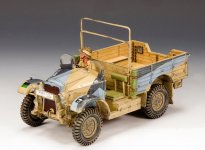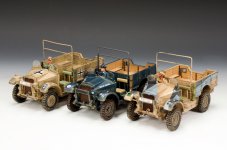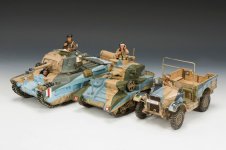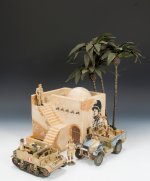Very nice addition to the North Africa series.
The black over green rectangle on front left is the colour patch of the 1st Battalion and for those who might be interested the following is a brief summary of the Battalion's WWII action taken from the War Memorial Web page :
The 2/1st Battalion was raised at Victoria Barracks, Sydney, on 16 October 1939 as part of the 16th Brigade of the 6th Australian Division. It relocated to the newly-opened Ingleburn Camp on 2 November and, after conducting basic training there, embarked for overseas service on 10 January 1940.
Disembarking in Egypt on 13 February 1940, the 2/1st moved to Palestine, where it was concentrated with the rest of the 16th Brigade at Julis near Gaza. The brigade trained in Palestine until the end of August, when it moved to Egypt to carry out its final preparations for active service with the 6th Division.
The 2/1st Battalion’s first campaign of the Second World War was the advance from Egypt into eastern Libya in January and February 1941. The battalion was involved in the attacks to capture Bardia (3-5 January) and Tobruk (21-22 January), and was left to garrison Tobruk as the advance continued. It left Tobruk on 7 March, ultimately bound for Greece with the rest of the 6th Division.
The 2/1st Battalion arrived in Greece on 22 March and was soon deployed north to resist the anticipated German invasion. The battalion occupied positions at Veria on 7 April but, in the face of superior German force, it began a long withdrawal south on 12 April and was evacuated by sea from Megara on 25 April. The battalion landed on Crete the next day and was subsequently deployed with the 2/11th Battalion to defend the critical airfield at Retimo. The German airborne invasion of Crete began on 20 May but a tenacious defence denied them Retimo airfield until 30 May. German victories elsewhere on Crete, however, allowed them to concentrate overwhelming force against Retimo and, short of rations and ammunition, the 2/1st surrendered and became prisoners of war.
The battalion was rebuilt in Palestine and subsequently manned defences in northern Syria between October 1941 and January 1942. It left the Middle East, heading for the war against Japan, on 10 March 1942. The 16th and 17th Brigades, however, were diverted on the voyage home. Between 26 March and 13 July they defended Ceylon (present-day Sri Lanka) from possible Japanese attack. The 2/1st finally disembarked in Australia, at Melbourne, on 7 August 1942; less than 100 of the men who had originally sailed with it in January 1940 remained with the battalion.
In the South-West Pacific theatre the 2/1st Battalion fought in two campaigns - the advance along the Kokoda Trail to the Japanese beachheads between September 1942 and January 1943, and the drive to clear the Japanese from the Aitape-Wewak region of New Guinea between December 1944 and August 1945. The period in between was occupied with training in northern Queensland. The Kokoda Trail fighting, involving major battles at Eora Creek (20 -29 October), Gorari (9-12 November 1942) and Sanananda (20-21 November) was particularly costly, with over two-thirds of the battalion killed, wounded, or evacuated sick.
The 2/1st Battalion disbanded in December 1945.
Regards
Brett











